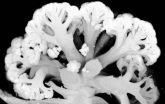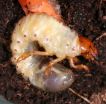(Press-News.org) LOUISVILLE, Ky. - Scarring of the airways can lead to long-term breathing problems for some people exposed to high levels of chlorine gas from events such as an industrial accident, chemical spill following a train derailment or terroristic chemical warfare. Household mishaps from mixing bleach with acidic cleaning products also can cause release of chlorine gas; if this occurs in a poorly ventilated space, chlorine levels could be high enough to cause lung injury.
University of Louisville scientist Gary Hoyle, Ph.D., School of Public Health and Information Sciences Department of Environmental and Occupational Health Sciences, and his team have uncovered new clues in understanding how epithelial cells - the cells that line the trachea, bronchi and other airways that carry air in and out of the lung - repair themselves after chlorine gas exposure. The findings were recently published in the American Journal of Physiology – Lung Cellular and Molecular Physiology in the article, Differential Susceptibility of Inbred Mouse Strains to Chlorine-Induced Airway Fibrosis. The research is funded by the National Institutes of Health (NIH) CounterACT program.
"The repair of injured epithelial cells is necessary to restore normal lung structure and function," Hoyle said. "The goal is to prevent scarring or fibrosis in the airways. It is a race between new epithelial cell growth and scar tissue development, and it takes about five to seven days after chlorine exposure for that to begin."
Following chlorine-related injury, Hoyle found that a type of epithelial cells called basal cells initiated the repair and served as progenitor cells – early descendants of stem cells that can differentiate to form one or more cell types. The progenitor cells helped restore new tissue in the airways.
"Structural changes in the respiratory system are difficult to reverse, so understanding how cells function and multiply can help us develop treatments to prevent scarring and subsequent asthma-like breathing problems that affect for a life time some people who've experienced high levels of chlorine exposure," Hoyle said.
This type of lung injury also can be caused by other types of industrial chemicals including ammonia, methylisocyanate and sulfur dioxide.
### END
UofL scientist uncovers how airway cells regenerate after chlorine gas injury
Discovery could lead to new treatments for respiratory injuries
2012-12-19
ELSE PRESS RELEASES FROM THIS DATE:
Closest sun-like star may have planets
2012-12-19
Washington, D.C.— An international team of scientists, including Carnegie's Paul Butler, has discovered that Tau Ceti, one of the closest and most Sun-like stars, may have five planets. Their work is published by Astronomy & Astrophysics and is available online.
At a distance of twelve light years and visible with a naked eye in the evening sky, Tau Ceti is the closest single star with the same spectral classification as our Sun. Its five planets are estimated to have masses between two and six times the mass of the Earth--making it the lowest-mass planetary system yet ...
NTU study finds ways to prevent muscle loss, obesity and diabetes
2012-12-19
A research study from Nanyang Technological University (NTU) has yielded important breakthroughs on how the body loses muscle, paving the way for new treatments for aging, obesity and diabetes.
The study found that by inhibiting a particular molecule produced naturally in the body, muscle loss due to aging or illnesses can be prevented. Blocking the same molecule will also trigger the body to go into a 'fat-burning mode' which will fight obesity and also treat the common form of diabetes.
The exciting discoveries have led NTU scientists to embark on joint clinical research ...
Successful results against human leishmaniasis with a more efficient and economic vaccine
2012-12-19
A research coordinated by the UAB has succeeded in testing a vaccine against leishmaniasis. The vaccine was tested with the best animal model existing, the golden hamster, and can be produced at low costs by using insect larvae. The research, published in the latest edition of PLoS ONE, is an important step towards the fight against a disease which causes the death of 70,000 people each year in developing countries and of countless dogs, which also suffer from this disease and are its natural reservoir.
Leishmaniasis is one of the main health problems existing at global ...
A mathematical formula to decipher the geometry of surfaces like that of cauliflower
2012-12-19
This press release is available in Spanish.
VIDEO:
This is a cauliflower.
Click here for more information.
The scientists have found a formula that describes how the patterns found in a multitude of natural structures are formed. "We have found a model that describes, in detail, the evolution in time and in space of cauliflower-type fractal morphologies for nanoscopic systems", explains ...
Geo-engineering against climate change
2012-12-19
Numerous geo-engineering schemes have been suggested as possible ways to reduce levels of the greenhouse gas carbon dioxide in the atmosphere and so reduce the risk of global warming and climate change. One such technology involves dispersing large quantities of iron salts in the oceans to fertilize otherwise barren parts of the sea and trigger the growth of algal blooms and other photosynthesizing marine life. Photosynthesis requires carbon dioxide as its feedstock and when the algae die they will sink to the bottom of the sea taking the locked in carbon with them.
Unfortunately, ...
Better approach to treating deadly melanoma identified by scientists
2012-12-19
Scientists at The University of Manchester have identified a protein that appears to hold the key to creating more effective drug treatments for melanoma, one of the deadliest cancers.
Researchers funded by Cancer Research UK have been looking at why new drugs called "MEK inhibitors", which are currently being tested in clinical trials, aren't as effective at killing cancer cells as they should be.
They discovered that MITF - a protein that helps cells to produce pigment but also helps melanoma cells to grow and survive - is able to provide cancer cells with a resistance ...
Fast-acting enzymes with 2 fingers: Protein structurally and dynamically explained
2012-12-19
Researchers at the RUB and from the MPI Dortmund have uncovered the mechanism that
switches off the cell transport regulating proteins. They were able to resolve in detail how the central switch protein Rab is down-regulated with two "protein fingers" by its interaction partners. The structural and dynamic data is reported by the researchers led by Prof. Dr. Klaus Gerwert (Chair of Biophysics, RUB) and Prof. Dr. Roger S. Goody (Max Planck Institute for Molecular Physiology, Dortmund, Germany) in the Online Early Edition of the journal PNAS. "Unlike in the cell growth protein ...
Badger sleeping habits could help target TB control
2012-12-19
Scientists found that badgers which strayed away from the family burrow in favour of sleeping in outlying dens were more likely to carry TB.
The 12-month study of 40 wild badgers was funded by the Department for Environment, Food and Rural Affairs (Defra) and could have implications for the management of bovine TB in parts of the UK. The behaviour of individual animals is thought to be a key factor in how the disease is spread among animals and livestock. The new findings could help to understand and develop measures to manage TB in badgers.
The study is published ...
The role of the innate immune cells in the development of type 1 diabetes
2012-12-19
The researchers reveal the role of the innate immune cells, especially the dendritic cells, that cause the activation of the killer T-lymphocytes whose action is directed against the p pancreatic cells. The results obtained in mice make it possible to consider new ways of regulating the auto-immune reaction generated by the innate immune cells.
Type 1 diabetes, or insulin-dependent diabetes, is an auto-immune disease characterised by the destruction of insulin-producing pancreatic β cells that are present in the Islets of Langerhans which are themselves in the pancreas. ...
Not without my microbes
2012-12-19
Apart from the common European cockchafer (Melolontha melolontha), the European forest cockchafer (Melolontha hippocastani) is the most common species of the Melolontha genus. These insects can damage huge areas of broadleaf trees and conifers in woodlands and on heaths. Cockchafers house microbes in their guts that help them to digest their woody food, such as lignocelluloses and xylans. Scientists of the Max Planck Institute for Chemical Ecology in Jena, Germany, have now performed comprehensive RNA analyses and identified the microbiota of cockchafer larvae feeding on ...
LAST 30 PRESS RELEASES:
What causes some people’s gut microbes to produce high alcohol levels?
Global study reveals widespread burning of plastic for heating and cooking
MIT study shows pills that communicate from the stomach could improve medication adherence
Searching for the centromere: diversity in pathways key for cell division
Behind nature’s blueprints
Researchers search for why some people’s gut microbes produce high alcohol levels
Researchers find promising new way to boost the immune response to cancer
Coffee as a staining agent substitute in electron microscopy
Revealing the diversity of olfactory receptors in hagfish and its implications for early vertebrate evolution
Development of an ultrasonic sensor capable of cuffless, non-invasive blood pressure measurement
Longer treatment with medications for opioid use disorder is associated with greater probability of survival
Strategy over morality can help conservation campaigns reduce ivory demand, research shows
Rising temperatures reshape microbial carbon cycling during animal carcass decomposition in water
Achieving ultra-low-power explosive jumps via locust bio-hybrid muscle actuators
Plant-derived phenolic acids revive the power of tetracycline against drug-resistant bacteria
Cooperation: A costly affair in bacterial social behaviour?
Viruses in wastewater: Silent drivers of pollution removal and antibiotic resistance
Sub-iethal water disinfection may accelerate the spread of antibiotic resistance
Three in four new Australian moms struggle with body image
Post-stroke injection protects the brain in preclinical study
Cardiovascular risk score predicts multiple eye diseases
Health: estimated one in ten British adults used or interested in GLP-1 medications for weight loss
Exercise to treat depression yields similar results to therapy
Whooping cough vaccination for pregnant women strengthens babies’ immune system
Dramatic decline in new cases of orphanhood in Uganda driven by HIV treatment and prevention programs
Stopping weight loss drugs linked to weight regain and reversal of heart health markers
Higher intake of food preservatives linked to increased cancer risk
Mass General Brigham–developed cholera vaccine completes phase 1 trial
First experimental validation of a “150-year-old chemical common sense” direct visualization of the molecular structural changes in the ultrafast anthracene [4+4] photocycloaddition reaction
Lack of support for people on weight loss drugs leaves them vulnerable to nutritional deficiencies, say experts
[Press-News.org] UofL scientist uncovers how airway cells regenerate after chlorine gas injuryDiscovery could lead to new treatments for respiratory injuries


